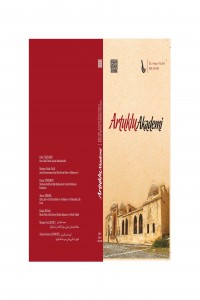Abstract
Throughout the Islamic
history, madrasas have a considerable contribution to education, which has
played a significant role in the preservation and transmission of Islamic
knowledge. As a result of the “Unity of Education Act” passed in 1924, all
madrasas were officially closed down in Turkey, but network of the clandestine
madrasas have functioned as mechanism of social integration in Southeastern
Anatolia. Known as Eastern Madrasas, these Islamic schools were important
centers of education and cultural transmission, some of which still exist
today. The purpose of the present study is to investigate the institutional
structure and functioning of eastern madrasas which are still active in Mardin
province. As field researcher, the author of the study interviewed the teachers
(structured and semi-structured interviews), conducted a survey of madrasa
students, and finally analyzed the data.
References
- Akgündüz, Murat, Osmanlı Medreseleri XIX. Asır, İstanbul, Beyan Yay., 2004.
- Akyüz, Yahya, Türk Eğitim Tarihi M.Ö. 1000 M.S. 2010, Ankara, Pegem Akademi Yay.,16. Baskı, 2010.
- Altıntop, Ömer, PKK Gerçeği ve Kürt Sorunu, İstanbul, MYKitap Yay., I. Baskı, 2011.
- Atalay, Talip, “Şafi Geleneğinin Yaygın olduğu Yörelerde İlköğretimde Din Eğitiminin Bazı Zorlukları”, Sosyal Bilimler Araştırma Dergisi, 2006.
- Baltacı, Cahit, XV ve XVI Yüzyıllarda Osmanlı Medreseleri, İstanbul, İFAV Yay., 2. Baskı, 2005.
- Bruinessen, Martin Van, ‘Ağa, Şeyh, Devlet’, çev.: Banu Yalkut, İstanbul, İletişim Yay., 6. Baskı, 2010.
- Büyüköztürk, Şener- Çakmak, Ebru K. (komisyon), Bilimsel Araştırma Yöntemleri, Ankara, PegemA Yay., 2009.
- Cebeci, Suat, “Din Eğitiminde Medreseden Mektebe, Mektepten Nereye?”, Sakarya Üniversitesi İlahiyat Fakültesi Dergisi, 2004.
- Çiçek, M. Halil, Şark Medreselerinin Serencamı, İstanbul, Beyan Yay., I. Baskı, 2009.
- Eroğlu, M. Şerif, Bütün Yönleriyle Arapkendi, İstanbul, Kent Yay., I. Baskı, 2004.
- Gül, Ahmed, Osmanlı Medreselerinde Eğitim-Öğretim ve Bunlar Arasında Dâru’l-Hadislerin Yeri, Ankara, TTK Yay., 1999.
- Kazıcı, Ziya, Osmanlı’da Eğitim-Öğretim, İstanbul, Bilge Yay., I Baskı, 2004.
- Makdisi, George, Ortaçağ’da Yüksek Öğretim ‘İslam Dünyası ve Hıristiyan Batı’, çev.: Ali Hakan Çavuşoğlu-Hasan Tuncay Başoğlu, İstanbul, Gelenek Yay., I. Baskı, 2004.
- Öcal, Mustafa, Medresetü’l-Eimmeve’l-Huteba’dan İmam Hatip Liselerine Bizim Okullarımız, İstanbul, Önder Yay., I. Baskı, 2011.
- Öngül, Ali, “Selçuklularda Eğitim Faaliyetleri ve Yetişen İlim Adamlarına Genel Bir Bakış”, Celal Bayar Üniversitesi Sosyal Bilimler Dergisi, 2003.
- Sarıkaya, Yaşar, Medreseler ve Modernleşme, İstanbul, İz Yay., I Baskı, 1997.
- Sarıkaya, Yaşar, “Osmanlı Medreselerinin Gerilemesi Meselesi: Eleştirel Bir Değerlendirme Denemesi”, İslam Araştırmaları Dergisi, 1999.
- Tezcan, Mahmut, Eğitim Sosyolojisi, Ankara, 11. Baskı, 1997.
- Yakuboğlu, Kenan, Osmanlı Medrese Eğitimi ve Felsefesi, İstanbul, Gökkubbe Yay., I. Baskı, 2006.
- Yıldırım, Ali - Şimşek, Hasan, Sosyal Bilimlerde Nitel Araştırma Yöntemleri, Ankara, Seçkin Yay., 6. Basım, 2006.
- Yurtseven, Ömer Alper, Türkiye’de Faaliyet Gösteren Dini Bir Terör Örgütü Olarak Hizbullah, Gebze İleri Teknoloji Enstitüsü Sosyal Bilimler Enstitüsü Strateji Anabilim Dalı, (Basılmamış Yüksek Lisans Tezi), 2006.
- Zengin, Zeki Salih, II. Meşrutiyet’te Medreseler ve Din Eğitimi, Ankara, Akçağ Yay., I. Baskı, 2002.
Abstract
İslam eğitim tarihi içerisinde medreseler önemli
roller üstlenmiş ve faaliyet gösterdikleri coğrafyalara önemli katkılar
yapmıştır. Anadolu’daki birçok medrese, 1924’te kabul edilen Tevhid-i Tedrisat Kanunu
ile kapatılmasına rağmen Doğu ve Güneydoğu’da ve kısmen Karadeniz’de varlığını
devam ettirmiştir. Özellikle Doğu ve Güneydoğu’da, söz konusu medreseler, birer
gayr-ı resmî eğitim kurumu olarak belli bir işleyiş çerçevesinde faaliyetlerine
devam etmektedir. Bu makale Mardin örneği üzerinden, Doğu ve Güneydoğu
medreselerinin kurumsal yapı ve işleyişlerini ele almıştır. Bu çerçevede
Mardin’deki medreselerde bulunan medreseli eğitimcilerle yapılandırılmış ve
yarı yapılandırılmış görüşmeler yapılmış, öğrencilere anketler uygulanmış; elde
edilen veriler tahlil edilmiştir.
References
- Akgündüz, Murat, Osmanlı Medreseleri XIX. Asır, İstanbul, Beyan Yay., 2004.
- Akyüz, Yahya, Türk Eğitim Tarihi M.Ö. 1000 M.S. 2010, Ankara, Pegem Akademi Yay.,16. Baskı, 2010.
- Altıntop, Ömer, PKK Gerçeği ve Kürt Sorunu, İstanbul, MYKitap Yay., I. Baskı, 2011.
- Atalay, Talip, “Şafi Geleneğinin Yaygın olduğu Yörelerde İlköğretimde Din Eğitiminin Bazı Zorlukları”, Sosyal Bilimler Araştırma Dergisi, 2006.
- Baltacı, Cahit, XV ve XVI Yüzyıllarda Osmanlı Medreseleri, İstanbul, İFAV Yay., 2. Baskı, 2005.
- Bruinessen, Martin Van, ‘Ağa, Şeyh, Devlet’, çev.: Banu Yalkut, İstanbul, İletişim Yay., 6. Baskı, 2010.
- Büyüköztürk, Şener- Çakmak, Ebru K. (komisyon), Bilimsel Araştırma Yöntemleri, Ankara, PegemA Yay., 2009.
- Cebeci, Suat, “Din Eğitiminde Medreseden Mektebe, Mektepten Nereye?”, Sakarya Üniversitesi İlahiyat Fakültesi Dergisi, 2004.
- Çiçek, M. Halil, Şark Medreselerinin Serencamı, İstanbul, Beyan Yay., I. Baskı, 2009.
- Eroğlu, M. Şerif, Bütün Yönleriyle Arapkendi, İstanbul, Kent Yay., I. Baskı, 2004.
- Gül, Ahmed, Osmanlı Medreselerinde Eğitim-Öğretim ve Bunlar Arasında Dâru’l-Hadislerin Yeri, Ankara, TTK Yay., 1999.
- Kazıcı, Ziya, Osmanlı’da Eğitim-Öğretim, İstanbul, Bilge Yay., I Baskı, 2004.
- Makdisi, George, Ortaçağ’da Yüksek Öğretim ‘İslam Dünyası ve Hıristiyan Batı’, çev.: Ali Hakan Çavuşoğlu-Hasan Tuncay Başoğlu, İstanbul, Gelenek Yay., I. Baskı, 2004.
- Öcal, Mustafa, Medresetü’l-Eimmeve’l-Huteba’dan İmam Hatip Liselerine Bizim Okullarımız, İstanbul, Önder Yay., I. Baskı, 2011.
- Öngül, Ali, “Selçuklularda Eğitim Faaliyetleri ve Yetişen İlim Adamlarına Genel Bir Bakış”, Celal Bayar Üniversitesi Sosyal Bilimler Dergisi, 2003.
- Sarıkaya, Yaşar, Medreseler ve Modernleşme, İstanbul, İz Yay., I Baskı, 1997.
- Sarıkaya, Yaşar, “Osmanlı Medreselerinin Gerilemesi Meselesi: Eleştirel Bir Değerlendirme Denemesi”, İslam Araştırmaları Dergisi, 1999.
- Tezcan, Mahmut, Eğitim Sosyolojisi, Ankara, 11. Baskı, 1997.
- Yakuboğlu, Kenan, Osmanlı Medrese Eğitimi ve Felsefesi, İstanbul, Gökkubbe Yay., I. Baskı, 2006.
- Yıldırım, Ali - Şimşek, Hasan, Sosyal Bilimlerde Nitel Araştırma Yöntemleri, Ankara, Seçkin Yay., 6. Basım, 2006.
- Yurtseven, Ömer Alper, Türkiye’de Faaliyet Gösteren Dini Bir Terör Örgütü Olarak Hizbullah, Gebze İleri Teknoloji Enstitüsü Sosyal Bilimler Enstitüsü Strateji Anabilim Dalı, (Basılmamış Yüksek Lisans Tezi), 2006.
- Zengin, Zeki Salih, II. Meşrutiyet’te Medreseler ve Din Eğitimi, Ankara, Akçağ Yay., I. Baskı, 2002.
Details
| Journal Section | Makaleler |
|---|---|
| Authors | |
| Publication Date | December 28, 2015 |
| Published in Issue | Year 2015 Volume: 2 Issue: 2 |
Cite
Artuklu Akademi is licensed under a Creative Commons Attribution-NonCommercial 4.0 International License.
PUBLISHER | JOURNAL BOARDS | INDEXES | PRICE POLICY | STATISTICS | MIAR | SHERPA ROMEO


